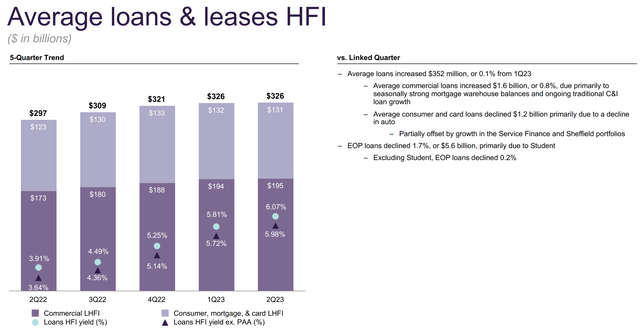The stock market is sometimes compared to a giant casino, and even blue chips names can swing more than 20% in either direction within the span of a year. But unlike a casino, in which the odds are reset on every game, value investors in the stock market can win over the long run simply by buying quality names when the chips are down, so long as the long term thesis isn’t broken.
This brings me to Truist Financial (NYSE:TFC), whose price has fallen by 32% over the past 12 months. The market did not appear to like TFC’s second quarter results, but in this article, I discuss why the negative reaction presents a solid opportunity for value investors with a longer investment time horizon.
Why TFC?
Truist Financial is a financial services company that’s headquartered in Charlotte, North Carolina, which is also home to Bank of America (BAC) and is otherwise known as the banking capital of the South. It serves 15 million clients in high growth markets, including 17 states and D.C. At present, TFC has $555 billion in total assets and is a Top 10 U.S. commercial bank.
Starting with the negatives, TFC’s stock price dropped in the high single digit post its Q2 earnings release, as the market didn’t take too kindly to net interest income falling by 6% and EPS falling by 12% since Q1, due to higher expenses and higher funding costs (i.e. higher interest rates on deposit accounts).
This was reflected by net interest margin falling to 2.91% from 3.17% in the prior quarter. While NII was up by 7% on a YoY basis, this was offset by higher loan loss provision and higher expenses, resulting in EPS declining by 16% on a YoY basis.
Notably, average deposits fell by $24 million on a YoY basis, from $424 billion to $400 billion. Collateral impact from the collapse of Silicon Valley Bank and Signature Bank appears to be muted, however, as the trend of decline started before those events took place, as shown below.
Investor Presentation
On the positive side, TFC’s total revenue still held up well, with it being up by 5% YoY and down 2.9% sequentially (in-line with guidance), and TFC generated a still strong ROTCE of 19%. TFC’s loan balance also held up well, with no decline on a sequential basis and rising by 10% YoY to $326 billion. This was achieved through strong YoY performance in both the consumer and commercial segments, as shown below.
Investor Presentation
Meanwhile, TFC is seeing strong digital engagement from its customers, with mobile app users rising by 6% over the past 4 quarters to 4.6 million users, and digital and Zelle transactions grew by 9% and 31%, respectively, over the same time period. TFC also has an AI-driven platform that assists small business clients with cash-flow summaries, P&L analysis, and proactive balance monitoring.
Risks to TFC include potential for a recession, which may put a strain on consumer finances and may result in higher loan loss provisions. Also, a continued higher funding costs without loan growth may continue to pressure margins. This could be offset by cost savings initiatives that management noted during the recent earnings call:
As a company, we have substantial opportunities to operate more efficiently and are committed to generating expense reductions. On the April earnings call, we discussed a strategic realignment within our fixed-income sales and trading business in which we discontinued certain market making activities and services provided by middle-market fixed-income platforms that had an unattractive ROE.
We also identified various expense reduction activities that had already been underway, including realigning our LightStream platform to our broader consumer business and ongoing capacity adjustments to market-sensitive businesses such as mortgage.
We’re actively working to identify and accelerate additional actions that could be implemented over the course of the next 12 to 18 months to generate cost reductions to reflect efficiency opportunities and changing conditions.
Importantly, TFC maintains a strong A- credit rating with a stable outlook from S&P. This is supported by a CET1 ratio of 9.6%, which sits well ahead of the 4.5% minimum requirement set by the Federal Reserve. TFC also pays an attractive 6.3% dividend yield, which comes with a 23% payout ratio, 8 years of consecutive growth, and an 8.8% 5-year CAGR. As shown below, the 6.3% yield is even higher than the pandemic high in 2020.
YCharts
At its current price of $33.05 and forward PE of 8.6, I see the potential risks as being more than priced into the stock. This is considering TFC’s normal PE of 14.3 and analyst expectations of TFC resuming bottom line EPS growth in the teens starting in 2025. TFC is also cheaply valued compared to peers, with an A- valuation grade and a PE that sits materially lower than the sector median, as shown below.
Seeking Alpha
Investor Takeaway
Truist Financial has experienced a significant price decline over the past 12 months, and the stock has declined since the Q2 earnings release. While there are some near-term headwinds, patient value investors could be rewarded over the long term, as I believe the issues are reversible as management works to implement expense reductions and increased digital engagement. Meanwhile, TFC maintains a well-covered and historically attractive dividend yield and has potential for long-term capital gains with a reversion to its mean valuation. As such, value and income investors may do well to have a look at TFC at its current discounted level.
Read the full article here











